Bird feet and legs

The anatomy ofbird legs and feetis diverse, encompassing many accommodations to perform a wide variety of functions.[1]
Most birds are classified asdigitigradeanimals, meaning they walk on theirtoesrather than the entire foot.[3][4]Some of the lower bones of the foot (thedistalsand most of themetatarsal) are fused to form thetarsometatarsus– a third segment of the leg, specific to birds.[5][6]The upper bones of the foot (proximals), in turn, are fused with thetibiato form thetibiotarsus,as over time thecentraliadisappeared.[7][6][4][8]Thefibulaalso reduced.[5]
The legs are attached to a strong assembly consisting of thepelvic girdleextensively fused with the uniform spinal bone (also specific to birds) called thesynsacrum,built from some of the fused bones.[8][9]

Hindlimbs
[edit]Birds are generallydigitigradeanimals (toe-walkers),[7][10]which affects the structure of their leg skeleton. They use only theirhindlimbsto walk (bipedalism).[2]Theirforelimbsevolved to becomewings.Most bones of the avian foot (excluding toes) are fused together or with other bones, having changed their function over time.
Tarsometatarsus
[edit]Some lower bones of the foot are fused to form thetarsometatarsus– a third segment of the leg specific to birds.[8]It consists of mergeddistalsandmetatarsalsII, III and IV.[6]Metatarsus I remains separated as a base of the first toe.[4]The tarsometatarsus is the extended foot area, which gives the leg extra lever length.[7]
Tibiotarsus
[edit]The foot's upper bones (proximals) are fused with thetibiato form thetibiotarsus,while thecentraliaare absent.[5][6]The anterior (frontal) side of the dorsal end of the tibiotarsus (at theknee) contains a protruding enlargement called thecnemial crest.[2]
Patella
[edit]At the knee above thecnemial crestis thepatella(kneecap).[4]Some species do not have patellas, sometimes only a cnemial crest. Ingrebesboth a normal patella and an extension of the cnemial crest are found.[2]
Fibula
[edit]Thefibulais reduced and adheres extensively to the tibia, usually reaching two-thirds of its length.[2][7][8]Onlypenguinshave full-length fibulae.[4]
Knee and ankle – confusions
[edit]
The birdkneejoint between thefemurandtibia(or rathertibiotarsus) points forwards, but is hidden within thefeathers.The backward-pointing "heel"(ankle) that is easily visible is a joint between thetibiotarsusandtarsometatarsus.[3][4]The joint inside the tarsus occurs also in some reptiles. It is worth noting here that the name "thick knee" of the members of thefamilyBurhinidaeis a misnomer because their heels are large.[2][8]
The chicks in the ordersCoraciiformesandPiciformeshave ankles covered by a patch of tough skins with tubercles known as theheel-pad.They use the heel-pad to shuffle inside the nest cavities or holes.[11][12]
Toes and unfused metatarsals
[edit]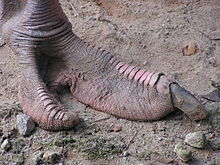
Most birds have four toes, typically three facing forward and one pointing backward.[7][10][8]In a typical perching bird, they consist respectively of 3, 4, 5 and 2phalanges.[2]Some birds, like thesanderling,have only the forward-facing toes; these are called tridactyl feet while theostrichhave only two toes (didactyl feet).[2][4]The first digit, called thehallux,ishomologousto the humanbig toe.[7][10]
Theclawsare located on the extreme phalanx of each toe.[4]They consist of a hornykeratinouspodotheca,or sheath,[2]and are not part of the skeleton.
The bird foot also contains one or two metatarsals not fused in thetarsometatarsus.[8]
Pelvic girdle and synsacrum
[edit]The legs are attached to a very strong, lightweight assembly consisting of thepelvic girdleextensively fused with the uniform spinal bone called thesynsacrum,[7][10]which is specific to birds. The synsacrum is built from thelumbarfused with thesacral,some of the first sections of thecaudal,and sometimes the last one or two sections of thethoracicvertebrae,depending on species (birds have altogether between 10 and 22 vertebrae).[9]Except for those ofostrichesandrheas,pubic bonesdo not connect to each other, easingegg-laying.[8]
Rigidity and reduction of mass
[edit]Fusions of individual bones into strong, rigid structures are characteristic.[1][7][10]
Most major bird bones are extensivelypneumatized.They contain many air pockets connected to the pulmonaryair sacsof therespiratory system.[13]Their spongy interior makes them strong relative to their mass.[2][7]The number of pneumatic bones depends on the species; pneumaticity is slight or absent indiving birds.[14]For example, in thelong-tailed duck,the leg and wing bones are not pneumatic, in contrast with some of the other bones, whileloonsandpuffinshave even more massive skeletons with no aired bones.[15][16]Theflightlessostrichandemuhave pneumaticfemurs,and so far this is the only known pneumatic bone in these birds[17]except for the ostrich's cervical vertebrae.[13]
Fusions (leading to rigidity) and pneumatic bones (leading to reduced mass) are some of the many adaptations of birds for flight.[1][7]
Plantigrade locomotion
[edit]Most birds, exceptloonsandgrebes,aredigitigrade,notplantigrade.[2]Also,chicksin thenestcan use the entirefoot(toes andtarsometatarsus) with the heel on the ground.[4]
Loons tend to walk this way because their legs andpelvisare highly specialized for swimming. They have a narrow pelvis, which moves the attachment point of thefemurto the rear, and theirtibiotarsusis much longer than the femur. This shifts the feet (toes) behind thecenter of massof the loon body. They walk usually by pushing themselves on their breasts; larger loons cannot take off from land.[10]This position, however, is highly suitable for swimming because their feet are located at the rear like thepropelleron amotorboat.[2]
Grebesand many other waterfowl have shorterfemurand a more or less narrow pelvis, too, which gives the impression that their legs are attached to the rear as inloons.[2]
Functions
[edit]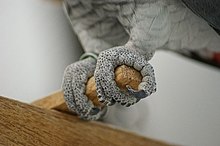
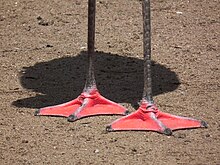
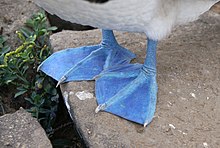

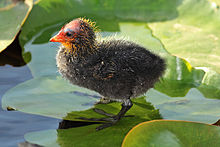


Because avianforelimbsarewings,many forelimb functions are performed by thebillandhindlimbs.[10]It has been proposed that the hindlimbs are important inflightas accelerators when taking-off.[18][19]Some leg and foot functions, including conventional ones and those specific to birds, are:
- Locomotion
- Walking, running (ostriches,grouse,wild turkeys) hopping, climbing (woodpeckers,nuthatches,treecreepers)[20]
- Swimming and steering underwater (ducks,grebes,loons)[3]
- Perching (as on a branch) or clinging[3]
- Carrying (likeospreysholdingfish)[3]
- Flight-related
- Serving probably as the primary take-off accelerator. In thecommon vampire bat,by contrast, the required force is generated by thewing.[18][19]
- Absorbing the shock of landing on a perch and on the water, becoming "water skis"[3]
- Feeding and related
- Catching and killing prey inraptors(hawks,owls)[3]
- Holding (used like hands inparrots) and pulling apart food (with help from thebill)[3]
- Scratching the ground in search of food[2]
- Double scratch: hopping forward and then backward using both feet to scratch (oftentowhees,sparrows,juncos)[2]
- One-footed scratch (grouse,quails,wild turkeys,domestic chicken)[2]
- Reproduction and related
- Cradling and turningeggsduring incubation.[3]Birds lacking abrood patchincubate the eggs with their feet – grasping one or even two of them (gannets,boobies) or keeping them on the top surfaces of their feet (penguinsunder a pouch of belly skin,murres).[1]
- Courtship (sage grouse), including aerial courtship (bald eagles)[3]
- Building nests (with help from thebill)[1]
- Preening and cleaning.[10]Sometimes birds use a specialclaw(for example,barn owlshave a so-called "feather comb" ). Someheronsandnightjarsuse the claw for cleaning the head.[2]
- Heat loss regulation (herons,gulls,giant petrels,storks,New World vultures,ducks,geese)[1][2]
Toe arrangements
[edit]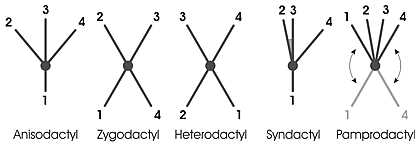
Typical toe arrangements inbirdsare:
- Anisodactyl:three toes in front (2, 3, 4), and one in back (1); in nearly allsongbirdsand most other perching birds.[4][20]
- Zygodactyl:two toes in front (2, 3) and two in back (1, 4) – the outermost front toe (4) is reversed. The zygodactyl arrangement is a case ofconvergence,because it evolved in birds in different ways nine times.[1][10]
- In many perching birds – mostwoodpeckersand their allies,ospreys,owls,cuckoos(includingroadrunners), mostparrots,mousebirds,someswiftsandcuckoo rollers.[20][4]
- Woodpeckers, when climbing, can rotate the outer rear digit (4) to the side in an ectropodactyl arrangement.Black-backed woodpeckers,Eurasian three-toed woodpeckersandAmerican three-toed woodpeckershave three toes – the inner rear (1) is missing and the outer rear (4) points always backward and never rotates.[10]
- Owls,ospreysandturacoscan rotate the outer toe (4) back and forth.[10]
- In many perching birds – mostwoodpeckersand their allies,ospreys,owls,cuckoos(includingroadrunners), mostparrots,mousebirds,someswiftsandcuckoo rollers.[20][4]
- Heterodactyl:two toes in front (3, 4) and two in back (2, 1) – the inner front toe (2) is reversed; heterodactyl arrangement only exists introgons.[20]
- Syndactyl:three toes in front (2, 3, 4), one in back (1); the inner and middle (2, 3) are joined for much of their length.[2][1]Common inCoraciiformes,includingkingfishersandhornbills.[7]
- Pamprodactyl:two inner toes in front (2, 3), the two outer (1, 4) can rotate freely forward and backward. Inmousebirdsand someswifts.Someswiftsmove all four digits forward to use them as hooks to hang.[20]
The most common arrangement is the anisodactyl foot, and second among perching birds is the zygodactyl arrangement.[3][7][21]
Claws
[edit]All birds have claws at the end of the toes. The claws are typically curved and the radius of curvature tends to be greater as the bird is larger although they tend to be straighter in large ground dwelling birds such as ratites.[22]Some species (includingnightjars,herons,frigatebirds,owls andpratincoles) have comb-like serrations on the claw of the middle toe that may aid in scratchpreening.[23]
Webbing and lobation
[edit]
Palmations and lobes enable swimming or help walking on loose ground such asmud.[3]The webbed or palmated feet of birds can be categorized into several types:
- Palmate:only the anterior digits (2–4) are joined by webbing. Found inducks,geeseandswans,gullsandterns,and other aquatic birds (auks,flamingos,fulmars,jaegers,loons,petrels,shearwatersandskimmers).[20][21]Diving ducksalso have a lobed hind toe (1), and gulls, terns and allies have a reduced hind toe.[24]
- Totipalmate:all four digits (1–4) are joined by webbing. Found ingannetsandboobies,pelicans,cormorants,anhingasandfrigatebirds.Some gannets have brightly colored feet used in display.[3][21]
- Semipalmate:a small web between the anterior digits (2–4). Found in someplovers(Eurasian dotterels) andsandpipers(semipalmated sandpipers,stilt sandpipers,upland sandpipers,greater yellowlegsandwillet),avocet,herons(only two toes), allgrouse,and some domesticated breeds ofchicken.Plovers andlapwingshave a vestigial hind toe (1), and sandpipers and their allies have a reduced and raised hind toe barely touching the ground. Thesanderlingis the only sandpiper having 3 toes (tridactyl foot).[3]
- Lobate:the anterior digits (2–4) are edged with lobes of skin. Lobes expand or contract when a bird swims. Ingrebes,coots,phalaropes,finfootsand some palmate-footedduckson the hallux (1). Grebes have more webbing between the toes than coots and phalaropes.[20][4][21]
The palmate foot is most common.
Thermal regulation
[edit]Some birds likegulls,herons,ducksorgeesecan regulate their temperature through their feet.[1][2]
Thearteriesandveinsintertwine in the legs, so heat can be transferred from arteries back to veins before reaching the feet. Such a mechanism is calledcountercurrent exchange.Gullscan open a shunt between these vessels, turning back the bloodstream above the foot, and constrict the vessels in the foot. This reduces heat loss by more than 90 percent. In gulls, the temperature of the base of the leg is 32 °C (89 °F), while that of the foot may be close to 0 °C (32 °F).[1]
However, for cooling, this heat-exchange network can be bypassed and blood-flow through the foot significantly increased (giant petrels). Some birds also excrete onto their feet, increasing heat loss viaevaporation(storks,New World vultures).[1]
See also
[edit]References
[edit]- ^abcdefghijklmGill, Frank B. (2001).Ornithology(2md ed.). New York: W.H. Freeman and Company.ISBN978-0-7167-2415-5.
- ^abcdefghijklmnopqrstuvwKochan, Jack B. (1994).Feet & Legs.Birds. Mechanicsburg: Stackpole Books.ISBN978-0-8117-2515-6.
- ^abcdefghijklmnKochan (1994);Proctor & Lynch (1993);Elphick et al (2001)
- ^abcdefghijklKowalska-Dyrcz, Alina (1990). "Entry: noga [leg]". In Busse, Przemysław (ed.).Ptaki[Birds]. Mały słownik zoologiczny [Small zoological dictionary] (in Polish). Vol. I (1st ed.). Warsaw: Wiedza Powszechna. pp. 383–385.ISBN978-83-214-0563-6.
- ^abcProctor & Lynch (1993);Kowalska-Dyrcz (1990);Dobrowolski et al (1981)
- ^abcdRomer, Alfred Sherwood; Parsons, Thomas S. (1977).The Vertebrate Body.Philadelphia, PA: Holt-Saunders International. pp. 205–208.ISBN978-0-03-910284-5.
- ^abcdefghijklmnProctor, Noble S.; Lynch, Patrick J. (1993). "Chapters: 6. Topography of the foot, 11. The pelvic girdle, and 12. The bones of the leg and foot Family".Manual of Ornithology. Avian Structure & Function.New Haven and London:Yale University Press.pp. 70–75, 140–141, 142–144.ISBN978-0-300-07619-6.
- ^abcdefghDobrowolski, Kazimierz A.; Klimaszewski, Sędzimir M.; Szelęgiewicz, Henryk (1981). "Chapters: Gromada: Ptaki - Aves: Układ kostny; Pas miednicowy i kończyna tylna [Class: Birds: The skeletal system; The pelvic girdle and the hindlimb]".Zoologia[Zoology] (in Polish) (4th ed.). Warsaw: Wydawnictwo Szkolne i Pedagogiczne. pp. 462–464, 469.ISBN978-83-02-00608-1.
- ^abKowalska-Dyrcz, Alina (1990). "Entry: synsakrum [synsacrum]". In Busse, Przemysław (ed.).Ptaki[Birds]. Mały słownik zoologiczny [Small zoological dictionary] (in Polish). Vol. II (1st ed.). Warsaw: Wiedza Powszechna. p. 245.ISBN978-83-214-0563-6.
- ^abcdefghijkElphick, John B.; Dunning, Jack B. Jr.; Sibley, David Allen (2001).National Audubon Society: The Sibley Guide to Bird Life & Behavior.New York: Alfred A. Knopf.ISBN978-0-679-45123-5.
- ^Munn, Philip W. (1 January 1894). "On the Birds of the Calcutta District".Ibis.36(1): 39–77.doi:10.1111/j.1474-919x.1894.tb01250.x.ISSN1474-919X.
- ^Chasen, F. N. (1923). "On The Heel-Pad in certain Malaysian Birds".Journal of the Malayan Branch of the Royal Asiatic Society.1(87): 237–246.JSTOR41559544.
- ^abWedel, Mathew J. (2003)."Vertebral pneumaticity, air sacs, and the physiology of sauropod dinosaurs"(PDF).Paleobiology.29(2): 243–255.doi:10.1666/0094-8373(2003)029<0243:vpasat>2.0.co;2.
- ^Schorger, A. W. (September 1947)."The deep diving of the loon and old-squaw and its mechanism"(PDF).The Wilson Bulletin.59(3): 151–159.
- ^Fastovsky, David E.; Weishampel, David B. (2005).The Evolution and Extinction of the Dinosaurs(2nd ed.). Cambridge, UK: Cambridge University Press.ISBN978-0-521-81172-9.
- ^Gier, H. T. (1952)."The air sacs of the loon"(PDF).The Auk.69(1): 40–49.doi:10.2307/4081291.JSTOR4081291.
- ^Bezuidenhout, A.J.; Groenewald, H.B.; Soley, J.T. (1999)."An anatomical study of the respiratory air sacs in ostriches"(PDF).Onderstepoort Journal of Veterinary Research.66(4): 317–325.PMID10689704.
- ^abEarls, Kathleen D. (Feb 2000)."Kinematics and mechanics of ground take-off in the starling Sturnis vulgaris and the quailCoturnix coturnix"(PDF).The Journal of Experimental Biology.203(Pt 4): 725–739.doi:10.1242/jeb.203.4.725.PMID10648214.
- ^abWhitfield, John (10 March 2000)."Off to a flying jump-start: Nature News".Nature.Nature Publishing Group.doi:10.1038/news000316-1.Retrieved17 January2014.
- ^abcdefgGill (2001);Kochan (1994);Proctor & Lynch (1993);Elphick et al (2001)
- ^abcdKalbe, Lothar (1983). "Besondere Formen für spezielle Aufgaben der Wassertiere [Special adaptations of aquatic animals to specific lifestyles]".Tierwelt am Wasser[Wildlife by the Water] (in German) (1st ed.). Leipzig-Jena-Berlin: Urania-Verlag. pp. 72–77.
- ^Pike, A. V. L.; Maitland, D. P. (2004). "Scaling of bird claws".Journal of Zoology.262:73–81.doi:10.1017/S0952836903004382.
- ^Stettenheim, Peter R. (August 2000). "The Integumentary Morphology of Modern Birds—An Overview".American Zoologist.40(4): 461–477.CiteSeerX10.1.1.559.1172.doi:10.1668/0003-1569(2000)040[0461:timomb]2.0.co;2.ISSN0003-1569.
- ^Kochan (1994);Elphick et al (2001)
